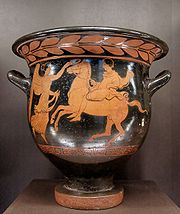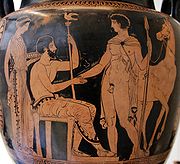
Sisyphus Painter
Encyclopedia


Apulia
Apulia is a region in Southern Italy bordering the Adriatic Sea in the east, the Ionian Sea to the southeast, and the Strait of Òtranto and Gulf of Taranto in the south. Its most southern portion, known as Salento peninsula, forms a high heel on the "boot" of Italy. The region comprises , and...
n red-figure
Red-figure pottery
Red-figure vase painting is one of the most important styles of figural Greek vase painting. It developed in Athens around 530 BC and remained in use until the late 3rd century BC. It replaced the previously dominant style of Black-figure vase painting within a few decades...
vase painter
Apulian vase painting
Apulian vase painting was the leading South Italian vase painting tradition between 430 and 300 BC. Of the circa 20,000 surviving specimens of Italian red-figure vases, about half are from Apulian production, while the rest are from the four other centres of production, Paestum, Campania, Lucania...
. His works are dated to the last two decades of the fifth century and the very early fourth century BC.
The Sisyphus Painter is only known by this conventional name, as his true name remains unknown. He is one of the most influential painters in the Apulian vase painting tradition, and thus in all South Italian
South Italian
South Italian is a designation for ancient Greek pottery fabricated in Magna Graecia largely during the 4th century BC. The fact that Greek Southern Italy produced its own red figure pottery as early as the end of the 5th century BC. was first established by Adolf Furtwaengler in 1893...
vase painting. His conventional name is derived from the inscription on the heart-shaped gift held by a youth as part of the depiction of a wedding on one of his volute kraters. He follows the tradition of the Painter of the Berlin Dancing Girl in whose workshop he is assumed to have started. Arthur Dale Trendall
Arthur Dale Trendall
Arthur Dale Trendall AC CMG was a New Zealand-born Australian art historian and classical archaeologist whose work on identifying the work of individual artists on Greek ceramic vessels at Apulia and other sites earned him international prizes and a papal knighthood...
described the Sisyphus Painter as "probably the dominant artist of the Taras
Taras
Taras may mean:* Taras, ancient city of Magna Graecia, modern Taranto.* Taraš, a village in Vojvodina, Serbia.* Taras , the son of Poseidon and of the nymph Satyrion....
School". Nonetheless, the quality of his works is uneven. Especially on larger vases he showed his quality as a painter of heads, often depicted in a three-quarter profile.
His early work includes a variety of bell kraters, usually decorated with three figures. He mainly painted scenes of everyday life or dionysiac scenes. On the backs he always painted two or three cloaked youths. Towards the later phase of his activity, the quality of his work deteriorated, many of his late paintings appear very stereotypical, thr facs rounder, their features coarser. His range of subjects also turns less and less imaginative, limited almost entirely to youths, warriors and women.

Attica
Attica is a historical region of Greece, containing Athens, the current capital of Greece. The historical region is centered on the Attic peninsula, which projects into the Aegean Sea...
artists, namely the Dwarf Painter and the Kodros Painter. There are also some similarities between his work and that of Polion. The Sisyphus Painter stands at the starting point of both main currents of later Apulian vase painting: on the one hand the "Plain Style", with simple figural compositions on smaller vessels, on the other hand the "Ornate Style" with large vases depicting scenes connected with funerary rituals and grave cult. Some other important Apulian painters were closely connected with him, e.g. the Hearst Painter. The Tarporley Painter
Tarporley Painter
The Tarporley Painter was an Apulian red-figure vase painter. His works date to the first quarter of the 4th century BC. The Tarporley Painter is his period's most important representative of the so-called "Plain Style"...
was his pupil and successor at his workshop.

